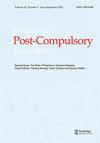Step into a new dimension with augmented reality. Can Augmented Reality (AR) replicate the tactile experience in a virtual mathematics classroom and what is the impact on engagement and deeper understanding?
IF 0.9
Q3 EDUCATION & EDUCATIONAL RESEARCH
引用次数: 1
Abstract
ABSTRACT The global pandemic has changed the mode of delivering lessons. Adult learners have missed and continue to miss the hands-on learning activity, which is a form of experiential learning. When it comes to teaching three-dimensional, geometric shapes (3D), learners often benefit from handling and manipulating concrete shapes. This study examined the use of an AR mobile application, as a learning tool for teaching geometric shapes in virtual mathematics classrooms. Data was collected from thirty learners at Functional Skills and General Certificate of Secondary Education (GCSE) levels in a Further Education college in Birmingham, UK. Learners were divided into Control and Experimental groups. The Control group used traditional learning materials, while in the Experimental group, an AR application was utilised during lessons. Qualitative data was gathered using mixed methods of one-to-one interviews and questionnaires to evaluate the learners’ experience. The data was triangulated with observation and note-taking by the teacher. In this study, the content analysis method has been used to analyse the data. Results showed an improved activity and interactivity within the session, when compared to the traditional, passive, teaching and learning strategies used in the learning process. From the results of this study, we can deduce that AR-based tools are a beneficial resource in teaching mathematics and improving learner experience in virtual classrooms. Further studies are required to evaluate quantitative improvements in student performance, as well as to implement AR as a regular teaching strategy.通过增强现实进入一个新的维度。增强现实(AR)可以在虚拟数学教室中复制触觉体验吗?对参与度和更深层次的理解有什么影响?
全球大流行改变了授课模式。成人学习者已经并将继续错过实践学习活动,这是一种体验式学习的形式。当涉及到三维,几何形状(3D)的教学时,学习者通常受益于处理和操纵具体的形状。本研究考察了AR移动应用程序的使用,作为虚拟数学教室中几何形状教学的学习工具。数据是从英国伯明翰一所继续教育学院的30名学习功能技能和普通中等教育证书(GCSE)水平的学习者中收集的。学习者被分为对照组和实验组。对照组使用传统的学习材料,而实验组在课堂上使用AR应用程序。采用一对一访谈和问卷调查相结合的方法收集定性数据,对学习者的学习体验进行评价。这些数据是由老师通过观察和记笔记进行三角测量的。本研究采用内容分析法对数据进行分析。结果显示,与在学习过程中使用的传统的、被动的教学策略相比,会话中的活动和互动性得到了改善。从本研究的结果中,我们可以推断出基于ar的工具是一种有益的数学教学资源,可以改善虚拟课堂中的学习者体验。需要进一步的研究来评估学生表现的量化改善,以及将AR作为常规教学策略来实施。
本文章由计算机程序翻译,如有差异,请以英文原文为准。
求助全文
约1分钟内获得全文
求助全文
来源期刊

Research in Post-Compulsory Education
EDUCATION & EDUCATIONAL RESEARCH-
CiteScore
1.30
自引率
14.30%
发文量
31
期刊介绍:
Throughout the world, there is a growing awareness of the significance of vocational and post-compulsory education and training systems. The majority of countries are working hard to develop their provision, recognising the importance of post-compulsory education in providing educated and skilled people in sufficient numbers at appropriate levels to assist economic and social development. Research in Post-Compulsory Education, sponsored by the United Kingdom"s Further Education Research Association (FERA), recognises the need for more international research and analysis and the generation of relevant theory in order to identify policy needs and trends as well as priorities in this growing area.
 求助内容:
求助内容: 应助结果提醒方式:
应助结果提醒方式:


